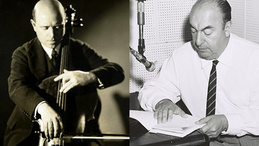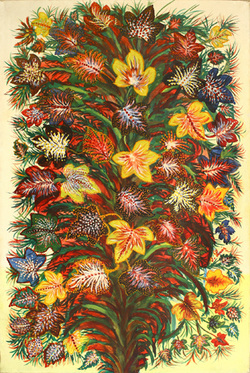 Marie Arana, author and Senior Adviser to the U.S. Librarian of Congress, moderated the well blended multimedia conversation, at the Kennedy Center on Friday evening, about three Pablos; Neruda, Picasso and Casals who established permanent footsteps in the Spanish speaking world and beyond, with their innovative and sometimes revolutionary perspectives within the realms of poetry, painting and music. All three passed away in the year of 1973. And their lives were delved into as a, "true nexus of the arts," Arana stated. "The men were contemporaries and friends who lived and worked during a politically charged time," she said. Arana described Pablo Neruda, of Chile as, "a literary master who taught Latin Americans who they were," and in a short film, the poet is revealed to be a person who cut across class and political boundaries to bring his message to the world. Neruda says of himself, "I'm a human being above all else and I've made many mistakes." Julia Alvarez, author and literary scholar describes Neruda and her love for his poetry that came while receiving her MFA, and how she found that the poetry of Neruda did not directly translate into English but needed to be read in its Spanish form. There was a theme that language is not just a method of communication but is a home. Dr. Marilyn McCully, who is a known scholar on the life and works of Picasso, spoke of a man who was born with unique talent and first presented his work, to acclaim through the press, at the age of thirteen. He was greatly influenced by El Greco (Doménikos Theotokópoulos) and Francisco Goya, with Spanish culture having a constant impact on the dynamic and mediums of his works. McCully delved into how Picasso was known in life, for his dark moods and intense eyes. He had a series of women, sometimes overlapping, and rarely, if ever liked to live alone. The film of Picasso, composed by Ruth Schell, was wryly amusing, showing him, an elderly man wearing only shorts, beginning to paint on a wall a mural with a dove. Workers came the next day and thought it was an unimportant sketch and took it down to Picasso's irate sensibilities. McCully delves into the many definitions of Picasso's work including; modernist, cubist, Africanist, as well as neoclassicist and indeed there is an amazing variety to his work. Marta Casals Istomin, Artistic Director of the Kennedy Center from 1980 to 1990, and widow of Pablo Casals gave a vivid view of a man who played and taught the cello with passion and integrity to equal degree. Her husband's public concerts were largely affected by political discourse including from the two Great World Wars. The Song of the Birds reflecting a request for peace, is mentioned as a favorite work. A film of Casals, also composed by Schell, shows him as a middle aged man teaching a student to play his cello in a way that gives both the cello and all the music from it, a sense of life. Then there are scenes of horror, women running with bloodied children in their arms, from the Spanish Civil War that began in 1936. Casals spoke of how once one is affected by such a violence, one's life and music is made to prevent such happenings from occurring again and as politics bled into art, Casals refused to play in concert under Francisco Franco. His widow carries on his legacy in preserving his memory and she lends his Matteo Goffriller cello (1700) to those worthy of playing it. The evening closed with Saint-Saëns Allegro Appassionato, Op. 43, J.S. Bach's Aria from Organ Pastoral in F Major, BVW 590, and Popper's Tarantella for Cello and Piano, Op. 33; played by Amit Peled and Members of the Peabody Institute. By Sarah Bahl  Seraphine, Feuilles D'automne 1928-30 Seraphine, Feuilles D'automne 1928-30 Séraphine (directed by Martin Provost), recently screened at the French Embassy is a movie about the triumph of human character over circumstance. The story begins with a woman hunched over, collecting mud and water from a pond. She wears a blue shawl. Her body is dowdy, and her dress shapeless. She hums to herself and looks about her with adorable, inquisitive blue-grey eyes. She likes to sit in a tree and smell the air with the breeze blowing her forever unkept hair about. This is Séraphine, a servant for patrons in a fairly small town at the dawn of World War I in France. She manages, despite the plethora of errands she runs during the day, to paint. And paint she does. By creating mixtures out of nature and some bought supplies. Some stolen, as well. However she needs to paint, she does. She sings to herself as she paints, much to the non-entertainment of the dwellers one floor below her. She is lovable, weird, as awkward as she is natural, and very, very much herself. One of the tenants, Wilhelm Uhde, is renting a flat from Séraphine’s mistress. Uhde is a frontrunner in the art world and a well noted critic. He takes a liking to Séraphine and she to him. She lets him know she paints and the word of Séraphine’s exploits travels to her mistress; who of course, demands to see Séraphine’s work, only so she can mock it and tell Séraphine to give up. The mistress’s son, stands up for Séraphine’s work, and keeps his mother from throwing it away altogether. The piece is laying to the side on the wall in the dining room, when it is noticed by Uhde during a dinner. He demands to know who the painter is and the mistress reluctantly has to admit that it is Séraphine. Uhde becomes Séraphine’s patron and protector. He has to encourage her to sell her work and she seems reluctant because she is afraid of losing her place. Of breaking with the traditions within her own life of servitude. But Uhde convinces her and she agrees to exhibit and sell her work. It is a “pure” relationship as Uhde informs Séraphine that he will never marry a woman in his life. Uhde has to leave France as the War progresses but comes across her work at a local show many years after the War has ended. The two strike up a relationship once more and Séraphine’s art sells as part of what is known as the naïve genre. She continues to paint, but her relationship with Uhde is strained due to her spending habits. She spends more than is coming in and on the oddest things. Such as a wedding dress, when there is no actual wedding. Séraphine’s eccentricities descend into a sad outright madness. She dons her wedding dress and by herself in bare feet, walks through the town knocking on doors and leaving empty silvered candleholders on the doorsteps. At the top of the town stairs are local authorities, waiting to take Séraphine away, in a van. She seems to know why they are there and submits without any confrontation. She just gets into the van, barefoot and in her beautiful dress. The cinematography throughout the film is breathtakingly clear, as if to reflect the purity of Séraphine’s soul and intentions. Uhde attempts to visit Séraphine, but she is too far gone. He makes her more comfortable, by buying her a place in a home where she can be alone. And the final scene is of Séraphine, sitting down on a chair in the middle of a field by herself under a large, comforting tree. Séraphine had the courage to tell a story of a world that begins and ends within herself. She became known as Séraphine of Senlis. It is still not known exactly how her paintings were made. They are of fruits and trees, as if in a child’s dream. By Sarah Bahl The image is from madamepickwickartblog.com |
Archives
June 2017
Categories
All
|
 RSS Feed
RSS Feed